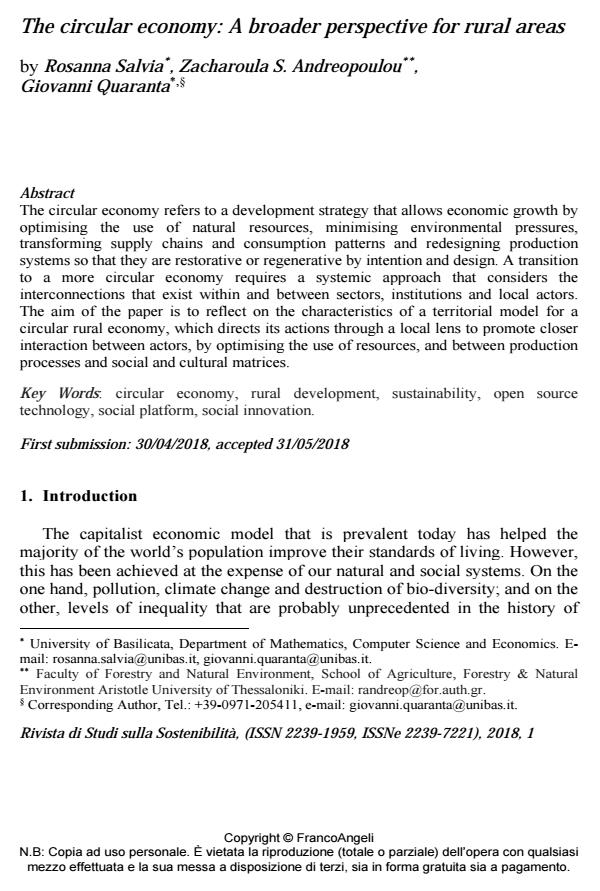The circular economy: A broader perspective for rural areas
Titolo Rivista RIVISTA DI STUDI SULLA SOSTENIBILITA'
Autori/Curatori Rosanna Salvia, Zacharoula S. Andreopoulou, Giovanni Quaranta
Anno di pubblicazione 2018 Fascicolo 2018/1
Lingua Inglese Numero pagine 19 P. 87-105 Dimensione file 258 KB
DOI 10.3280/RISS2018-001008
Il DOI è il codice a barre della proprietà intellettuale: per saperne di più
clicca qui
Qui sotto puoi vedere in anteprima la prima pagina di questo articolo.
Se questo articolo ti interessa, lo puoi acquistare (e scaricare in formato pdf) seguendo le facili indicazioni per acquistare il download credit. Acquista Download Credits per scaricare questo Articolo in formato PDF

FrancoAngeli è membro della Publishers International Linking Association, Inc (PILA)associazione indipendente e non profit per facilitare (attraverso i servizi tecnologici implementati da CrossRef.org) l’accesso degli studiosi ai contenuti digitali nelle pubblicazioni professionali e scientifiche
The circular economy refers to a development strategy that allows economic growth by optimising the use of natural resources, minimising environmental pressures, transforming supply chains and consumption patterns and redesigning production systems so that they are restorative or regenerative by intention and design. A transition to a more circular economy requires a systemic approach that considers the interconnections that exist within and between sectors, institutions and local actors. The aim of the paper is to reflect on the characteristics of a territorial model for a circular rural economy, which directs its actions through a local lens to promote closer interaction between actors, by optimising the use of resources, and between production processes and social and cultural matrices.
Parole chiave:Circular economy, rural development, sustainability, open source technology, social platform, social innovation.
- Environmental assessment of waste handling in rural Brazil: Improvements towards circular economy Priscila de Morias Lima, Mariane Franca de Morais, Michel Angelo Constantino, Paula Loureiro Paulo, Fernando Jorge Corrêa Magralhães Filho, in Cleaner Environmental Systems 100013/2021 pp.100013
DOI: 10.1016/j.cesys.2021.100013 - Introduction to the special issue on the contested realities of the circular economy Hervé Corvellec, Steffen Böhm, Alison Stowell, Francisco Valenzuela, in Culture and Organization /2020 pp.97
DOI: 10.1080/14759551.2020.1717733 - Circularities in territories: opportunities & challenges Sebastien Bourdin, Danielle Galliano, Amélie Gonçalves, in European Planning Studies /2022 pp.1183
DOI: 10.1080/09654313.2021.1973174 - Enablers of Managerial Practices for Circular Business Model Design: An Empirical Investigation of an Agro-Energy Company in a Rural Area Pasquale Del Vecchio, Andrea Urbinati, Julian Kirchherr, in IEEE Transactions on Engineering Management /2024 pp.873
DOI: 10.1109/TEM.2021.3138327 - CiaBOT: the circular design of an experimental microarchitecture between material and immaterial values Elena Montacchini, Silvia Tedesco, Nicolò Di Prima, in VITRUVIO - International Journal of Architectural Technology and Sustainability /2024 pp.44
DOI: 10.4995/vitruvio-ijats.2024.21492 - Teaching systemic design to foster sustainability learning in non-design curricula Amina Pereno, Asja Aulisio, in International Journal of Sustainability in Higher Education /2025
DOI: 10.1108/IJSHE-03-2024-0225 - The Energy System of an Ecovillage: Barriers and Enablers Zita Szabó, Viola Prohászka, Ágnes Sallay, in Land /2021 pp.682
DOI: 10.3390/land10070682
Rosanna Salvia, Zacharoula S. Andreopoulou, Giovanni Quaranta, The circular economy: A broader perspective for rural areas in "RIVISTA DI STUDI SULLA SOSTENIBILITA'" 1/2018, pp 87-105, DOI: 10.3280/RISS2018-001008